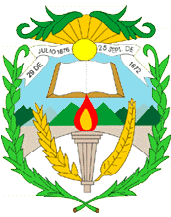Chiquimula Department
| Chiquimula | |
|---|---|
| Location of Chiquimula in Guatemala | |
| Data | |
| Capital | Chiquimula |
| population | 415,900 (calculation 2016) |
| surface | 2,376 km² |
| Population density | 175 inhabitants / km² |
| structure | 11 |
| Highest elevation | 2146 |
| ISO 3166-2 | GT-CQ |
| Coat of arms of the Chiquimula department | |
Chiquimula is a department of Guatemala and is located in the east of the country (Region III). It extends over 2,376 km² and has around 415,900 inhabitants. The capital of the department is the city of the same name, Chiquimula .
Chiquimula is bordered by the Zacapa department in the north, Honduras in the east, El Salvador and the Jutiapa department in the south, and Jalapa in the west .
National nature
The department of Chiquimula is located in a geographical and climatic transition area between the last foothills of the Sierra Madre de Chiapas in southern Guatemala, the Sierra del Merendón , which runs along the border with Honduras in the east, and the lowlands with the Río Motagua to the north, which open to the Caribbean . In Chiquimula there is a predominantly hilly and low mountain range, which rarely rises to over 1,500 m. In the very south, on the border with El Salvador, the Cerro Montecristo is the highest point at 2,146 m. The north is characterized by the valley landscapes around the capital Chiquimula and around Jocotán, which are around 400 m above sea level. At its northern end, several rivers that drain large parts of the department merge in the Río Grande , which in turn flows into the Río Motagua in the neighboring Zacapa. The climate is temperate to hot, the temperatures are generally between 14 and 27 ° C, in the lowlands the 30 degrees can be significantly exceeded. The average annual rainfall is 1,100 mm.
population
The population is predominantly of Spanish descent, but there are also a few smaller Chortí communities. The approximately 350,000 inhabitants of the department live in 11 municipalities ( large communities or districts ):
| Camotan | Chiquimula |
| Concepción Las Minas | Esquipulas |
| Ipala | Jocotan |
| Olopa | Quetzaltepeque |
| San Jacinto | San Jose La Arada |
| San Juan Ermita |
As a state administrative district , the department is headed by a governor sent by the central government . The Municipios are independent regional authorities with elected mayors and representatives of the people and are subdivided into Aldeas and Pueblos (rural communities) as well as Caseríos, Parajes, Fincas, Rancherías ( hamlets and farms ).
Economy and Transport
Economic life is shaped by agriculture. Are grown beans (with the best in Guatemala), corn , coffee , sugar cane , tobacco and various fruits and vegetables. The mining of raw materials such as zinc , lead and silver only plays a subordinate role. The tourism benefits from the pilgrimage town of Esquipulas, from the volcano located in the southwest Ipala (1,650 m) with its the water park developed lagoon and through traffic to Honduras ( Copan ) and El Salvador. Chiquimula is well connected to Guatemala City via the CA 9 Atlantic trunk road in neighboring Zacapa . The branch line from Zacapa to Chiquimula and El Salvador is no longer in operation. The city of Chiquimula has an airfield for general aviation .
history
Before the Spanish conquest, Chiquimula was ruled by the Chortí, who had immigrated from the south of what is now Mexico since the 10th century . From 1530 they were subjugated by the Spaniards and their mercenaries , who defeated the Chortí at Mictlán, Eskirpujá and Copántl, among others. Already during the colonial period Chiquimula formed a large administrative district called Corregimiento de Chiquimula , to which (at different times) the present-day departments of Jutiapa , Jalapa , El Progreso , Zacapa and Izabal belonged. Due to the corresponding political weight, Chiquimula tried shortly after independence from Spain to form its own state in 1822, but this was prevented by the central government of Guatemala with military means. From then on, Chiquimula formed an administrative district with Zacapa, which the government divided into the two current departments on November 10, 1871.
In the 19th century, due to its strategic importance, Chiquimula was the scene of several battles in which the armed forces of Guatemala asserted themselves against those of the neighboring countries. On February 2, 1852, General Rafael Carrera defeated the combined army of Honduras and El Salvador near San José La Arada.
For a long time, Chiquimula, which likes to call itself the "Pearl of the East", has been shaped by the pilgrimage site of Esquipulas, which is the destination of numerous believers from all over Central America . The local church with its Cristo Negro was founded in 1961 by Pope John XXIII. raised to the basilica . In 1986, at the end of the Guatemalan civil war, important international negotiations on peace, democratization and economic cooperation in Central America took place in Esquipulas .
Web links
Coordinates: 14 ° 45 ′ N , 89 ° 28 ′ W


